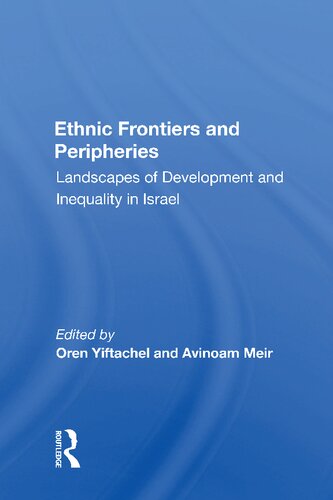

Most ebook files are in PDF format, so you can easily read them using various software such as Foxit Reader or directly on the Google Chrome browser.
Some ebook files are released by publishers in other formats such as .awz, .mobi, .epub, .fb2, etc. You may need to install specific software to read these formats on mobile/PC, such as Calibre.
Please read the tutorial at this link. https://ebooknice.com/page/post?id=faq
We offer FREE conversion to the popular formats you request; however, this may take some time. Therefore, right after payment, please email us, and we will try to provide the service as quickly as possible.
For some exceptional file formats or broken links (if any), please refrain from opening any disputes. Instead, email us first, and we will try to assist within a maximum of 6 hours.
EbookNice Team

Status:
Available0.0
0 reviews
ISBN 10: 0367017369
ISBN 13: 9780367017361
Author: Oren Yiftachel, Avinoam Meir
"The idea for editing this book originated during an international conference titled ""Regional Development: The Challenge of the Frontier,"" held in December 1993 at the Dead Sea and which was organized by the Negev Center for Regional Development at Ben-Gurion University of the Negev. In this conference we noticed that little has been said about the impact of Israel's complex mosaic of ethnic groups on the shaping of the country's social and spatial frontiers. We have therefore endeavored to bring together a number of perspectives on the evolution of ethnic frontiers in Israel and the role they play in shaping the cultural landscape of this country. Yet we later realized that ""frontier"" is too limited a term, and that it may through various processes have turned into a mosaic of spatial, social, economic, and political peripheries. More specifically we attempted to present the process of frontier development as perceived by Israel's ethnic and national minorities. We therefore invited contributions from various other Israeli experts on these issues: geographers, sociologists, anthropologists, and political scientists, which have now become the main body of chapters in this book. We trust that they are representative of the main dimensions of the subject."
1. Frontiers, Peripheries, and Ethnic Relations in Israel: An Introduction
PART ONE The Frontiers of Ethno-National Relations
2. Transforming Ethnic Frontiers of Conflict into Political Frontiers of Peace
3. The Internal Frontier: Territorial Control and Ethnic Relations in Israel
4. The Frontiers of Urban Mix: Palestinians, Israelis, and Settlement Space
5. Mizrahi Jews and Palestinian Arabs: Exclusionist Attitudes in Development Towns
PART TWO Frontiers, Peripheries, and Jewish Ethnicities
6. From Frontier to Periphery in Israel: Cultural Representations in Narratives and Counter-Narratives
7 Who to the Frontier? Changing Policies in the Peopling of Israel's Frontier
8. Spatial Patterns of Internal Migration to and from Development Towns in Israel
9. Planning for Ethiopian Jews in the Negev: Issues of Ethnicity and Citizen Identity
10. From Periphery to the Core: Sources of Ethnic Political Leadership
PART THREE The Frontiers, Peripheries, and Ethnic Encounters
11. Sociocultural Encounter on the Frontier: Jewish Settlers and Bedouin Nomads in the Negev
12. Minority Higher Education in an Ethnic Periphery: The Bedouin Arabs
13. Double Marginality: "Oriental" and Arab Women in Local Politics
14. Arab Industrial Frontiers: Sales Linkages and Spatial Integration
ethnic frontiers
ethnic studies libguide
phinney’s ethnic identity
frontiers 4-5
frontiers 4-4
frontiers 3-4
Tags: Oren Yiftachel, Avinoam Meir, Ethnic, Frontiers